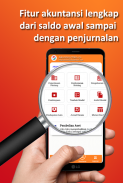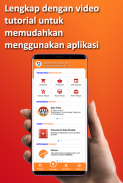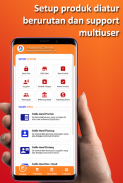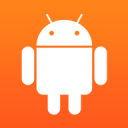








Akunting Toko-qu

Description of Akunting Toko-qu
This accounting-based shop software is designed to make it easier for business owners to run their business.
Sometimes we think making financial reports is very difficult and requires someone who is skilled in making financial reports but with this software you don't need to pay more to pay a financial expert to journaling every transaction because this program is designed to automatically make journaling directly.
Why is it called an accounting basis because in this software there is a journal system based on the current accounting system standards.
The operation of this software is designed to make it easier for users to create accounting-based financial reports even though the user does not master accounting because all journalizing is done automatically by the system. This software also features a stock-taking facility if there is a difference between recording and reality.
In addition, this software supports bluetooth and multi-user printers which are very useful for its users
A new feature is a security system for employees, namely employees can only operate the application during working hours so they cannot make transactions outside these hours
Supporting reports in accounting are:
1. Balance Sheet
2. Income Statement
3. Cash / Bank Receipt Report
4. Mutation Report / Auxiliary Ledger
5. Inventory Report
6. Credit / Cash Purchase Report
7. Credit / Cash Sales Report
8. Accounts Receivable Report
9. Accounts Payable
10. Sales Graph
11. Stock Opname
12. Edit Posted Transactions
13. Advances for Credit Purchases or Credit Sales
This store software transaction facilities are:
A. Beginning Balance
1. Initial product balance
2. opening balance of accounts receivable
3. Beginning balance of debt
4. Beginning cash / bank balance
5. Fixed asset data
6. depreciation of fixed assets
As a note, the opening balance is only inputted once when you first use the software because when you use it we have stock of goods, accounts receivable, payable and others that will be recognized as the beginning balance.
B. Transactions
1. Cash or credit purchases
2. Cash and credit sales
3. Stock taking
4. Receivables receivable
5. Payment of debt
6. Cash / Bank Disbursements
7. Cash / Bank Movements
8. Depreciation of fixed assets that must be done every month because the value of these assets is shrinking
9. Funding
10. Receipt of Custodian Goods
11. Payment of custodians based on the goods sold
12. Return of Custody
Other facilities are provided by User Level Security, which means that each user has access rights, for example the admin counter can only open sales transactions and other accesses are closed.
It is hoped that by using this accounting-based shop software, the owner does not have to always be in the store because he can access any transactions wherever he is.


























